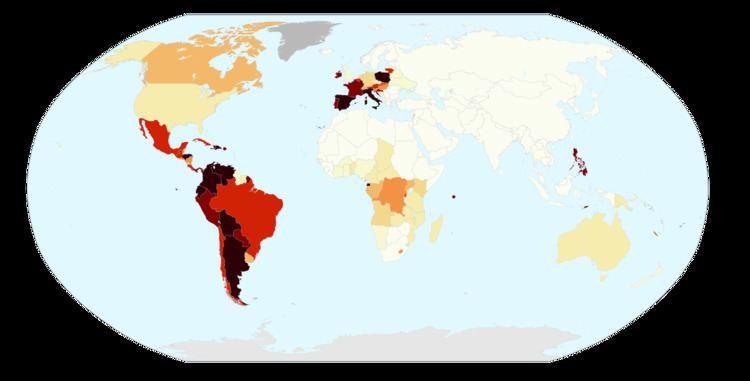 | ||
The Catholic Church in the United Kingdom is part of the worldwide Catholic Church in communion with the Pope. While there is no ecclesiastical jurisdiction corresponding to the political union, this article refers to the Catholic Church's geographical representation in the United Kingdom as well as Northern Ireland, ever since the establishment of the U.K.'s predecessor Kingdom of Great Britain by the Union of the Crowns in 1707.
Contents
For the Catholic Church in the British Isles before 1707, including during the Protestant Reformation, see:
Anti-Catholicism
Starting with Pope Pius V's Papal Bull Regnans in Excelsis in 1570 and lasting until 1766, Popes did not recognise the legitimacy of the English Monarchy and called for its overthrow. Therefore, by the time of the creation of the Kingdom of Great Britain in 1707, Catholics were discriminated against in England and Scotland in significant ways: in all the kingdoms of the British Isles, they were excluded from voting, from sitting in Parliament, and from the learned professions. These discriminatory laws continued after the Acts of Union 1800, which created the new United Kingdom of Great Britain and Ireland in 1801. At that time, Catholic Emancipation was gathering support but was not yet a reality, particularly in Ireland, where the Protestant Ascendancy was still in full force.
The Treaty of Union of 1707, like the Act of Settlement, had stated that no "Papist" could succeed to the throne. Restrictions on the civil rights of Roman Catholics only began to change with the passing of the Papists Act 1778, which allowed them to own property, inherit land and join the British Army, although even this measure resulted in the backlash of the Gordon Riots of 1780, showing the depth of continuing anti-Catholic feeling.
Emancipation
After 1790, a new mood emerged as thousands of Catholics fled the French Revolution and Britain was allied in the Napoleonic Wars with the Catholic states of Portugal and Spain as well as with the Holy See itself. By 1829, the political climate had changed enough to allow Parliament to pass the Roman Catholic Relief Act 1829, giving Roman Catholics almost equal civil rights, including the right to vote and to hold most public offices.
The Catholic Church in England comprised three elements. In England there were about 50,000 people in traditional ("recusant") Catholic families. They generally kept a low profile. Their priests usually came from St Edmund's College, a seminary founded in 1793 by English refugees from the French revolution. The main disabilities were lifted by the Catholic Emancipation Act of 1829. In 1850 the pope restored the Catholic hierarchy, giving England its own Catholic bishops again. In 1869 a new seminary opened.
The second large group comprised very poor Irish immigrants escaping the Great Irish Famine. Their numbers rose from 224,000 in 1841 to 419,000 in 1851, concentrated in ports and industrial districts as well as industrial districts in Scotland. The third group included well-known converts from the Church of England, most notably the intellectuals John Henry Newman and Henry Edward Manning (1808–1892). Manning became the second Archbishop of Westminster. The next most prominent leader was Herbert Vaughan (1832–1903), who succeeded Manning as Archbishop of Westminster in 1892 and was elevated to the cardinalate in 1893.
Manning was among the strongest supporters of the pope and especially of the doctrine of papal infallibility. In contrast Cardinal Newman acknowledged this doctrine but thought it might not be prudent to define it formally at the time. Manning promoted a modern Roman Catholic view of social justice. These views are reflected in the papal encyclical Rerum novarum issued by Pope Leo XIII. It was the foundation of modern Roman Catholic social justice teaching. Catholic parochial schools, subsidised by the government, were set up in urban areas to serve the largely Irish element. Manning spoke for the Irish Catholic labourers and helped settle the London Dock Strike of 1889. He gained acclaim for building a new cathedral in Westminister, and for encouraging the growth of religious congregations largely filled by the Irish.
Converts
A number of prominent individuals have converted to the Catholic Church, including Charles II, John Henry Newman, Augustus Pugin, Muriel Spark, Gerard Manley Hopkins, G. K. Chesterton, Ronald Knox, Evelyn Waugh, Graham Greene, Malcolm Muggeridge and Joseph Pearce. Members of the Royal family such as the Duchess of Kent and former Prime Minister Tony Blair have also converted to the Catholic Church, in Blair's case in December 2007 after he had left office.
Organisation
There are 38 ecclesiastical circumscriptions and 3,104 parishes.
Statistics
In 2011, in total there were roughly 5.7 million Catholics in the United Kingdom; 4,155,100 in England and Wales (7.4%), 841,053 in Scotland (15.9%), and 738,033 in Northern Ireland (40.76%).
In large parts of Northern Ireland, Catholicism is the dominant religion. Also in a few Scottish council areas Catholics outnumber other religions, including in the most populous one: Catholics outnumber members of the Church of Scotland in Glasgow City (27% versus 23%). Other council areas in which Catholics outnumber members of the Church of Scotland are North Lanarkshire, Inverclyde, and West Dunbartonshire, according to the 2011 Scottish Census.
